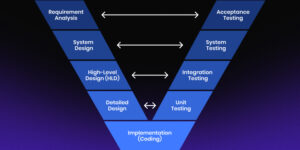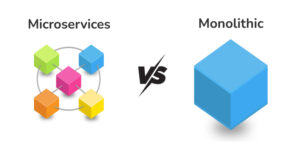
In software engineering, software architecture is the fundamental pillar of a robust and functional system. Acting as a blueprint, it outlines the interactions and functionalities of system components, guiding the development process. The significance of software architecture cannot be overstated—it shapes a project’s performance, maintainability, and scalability.
Like a well-designed cityscape, thoughtful architecture ensures seamless communication among elements, reducing complexities and enhancing flexibility, and empowering engineers to make informed decisions to foster sustainable solutions that endure the test of time. Software engineering risks stumbling into confusion and instability without a solid architectural foundation.
What is Software Architecture?
Software architecture is the underlying framework that defines how a software system is structured and organized. It encompasses the high-level design decisions that determine how various components will interact and communicate with each other to achieve the system’s objectives.
Think of it as the blueprint or the master plan that guides the construction of a complex digital structure. When paired with automated software testing services, a robust software architecture ensures efficient validation of the system’s functionality, reliability, and scalability.
Just as a well-designed building relies on a solid architectural plan to ensure stability, efficiency, and functionality, software architecture is the backbone of a software project. It influences the system’s performance, scalability, and maintainability, laying the groundwork for a successful and sustainable solution. Software architecture shapes the software’s essence and behavior, making it a crucial aspect of software development. To create a strong software architecture, partnering with a skilled custom software development company can be invaluable.
Why is Software Architecture Important?
Software architecture is of paramount importance in the field of software development due to several compelling reasons
- It provides a blueprint that guides the development process, enabling software engineers to design a well-organized and efficient system.
- It helps manage complexity by breaking down the system into manageable components, making it easier to understand and maintain.
- A well-thought-out architecture ensures the system’s scalability, allowing it to handle increasing demands and future growth.
- It addresses non-functional requirements such as performance, security, and reliability, ensuring the software meets user expectations.
Generally, software architecture plays a critical part in delivering successful, reliable, and maintainable software solutions.
The Role of Software Architecture in Software Development
- Software architecture provides a comprehensive blueprint for the system, guiding developers in building a cohesive and functional software product.
- It manages complexity by breaking down intricate tasks into manageable and modular components, fostering easier understanding, maintenance, and future enhancements.
- A well-designed architecture enables scalability, allowing the system to handle increased user demands and growing data volumes without compromising performance.
- It enables flexibility and adaptability, allowing the software to seamlessly accommodate changes or incorporate new features, reducing development time and costs.
- Software architecture addresses critical non-functional requirements, including performance, security, and reliability, ensuring the system meets and exceeds user expectations.
- Facilitating efficient communication and collaboration among development teams, software architecture aligns efforts toward a unified goal, creating a successful, high-quality software solution.
Impact of Software Architecture on Project Success
A. How a Good Architecture Can Lead to Project Success
- A well-designed software architecture establishes a solid foundation for the project, ensuring clear direction and alignment with project goals.
- It enables effective complexity management, making the system easier to understand, develop, and maintain throughout the project’s lifecycle.
- Good architecture promotes modularity and reusability, allowing developers to work on independent components, which leads to faster development and reduced time-to-market.
- A robust architecture allows the system to quickly adjust to varying needs and acclimate prospective enhancements without significant disruptions.
- Properly addressing non-functional requirements, such as performance and scalability, ensures that the software can handle user demands and grows seamlessly as the user base expands.
- A good architecture encourages collaboration and communication among team members, improving teamwork and problem-solving capabilities.
- It enhances the system’s reliability, reducing the risk of critical failures and consequently improving user satisfaction and trust in the software.
B. Consequences of Poor Architectural Decisions
- Poor architectural decisions can result in an overly complex system, leading to confusion among developers and increasing the chances of bugs and errors.
Related Article: What is Debugging Software Engineering and It’s Techniques?
- Inadequate architecture may hinder scalability, causing performance bottlenecks and restricting the software’s ability to handle increasing user loads.
- A flawed architecture makes adapting to changing requirements challenging, leading to costly and time-consuming modifications that disrupt the project’s timeline.
- Neglecting non-functional requirements like security may expose the system to vulnerabilities, making it susceptible to cyber-attacks and compromising user data.
- A lack of modularity and reusability can lead to code duplication and maintenance issues, reducing overall development efficiency and increasing long-term costs.
- Poor architectural decisions may result in a fragmented team, as conflicts arise from disagreements on the best course of action.
- It can ultimately lead to project failure, as the software becomes unstable, unreliable, and fails to meet user expectations, resulting in a loss of credibility and potential business opportunities.
The Software Architecture Design Process
A. Gathering Requirements and Understanding Stakeholder Needs
- Conduct thorough discussions and interviews with stakeholders to understand their objectives, anticipations, and specific needs.
- Identify functional and non-functional requirements that will shape the architecture.
- Analyze user needs and potential future demands to ensure the architecture is adaptable and scalable.
- Collaborate with stakeholders to prioritize and clarify requirements, ensuring alignment with the overall project vision.
B. Identifying Architectural Patterns and Frameworks
- Research and explore various architectural patterns and frameworks suitable for the project’s scope and requirements.
- Evaluate the pros and cons of each pattern to choose the one that best fits the project’s needs.
- Consider modularity, performance, and maintainability when choosing the appropriate architectural style.
- Leverage industry best practices and lessons from past projects to inform decision-making.
C. Creating High-Level Design and System Components
- Develop a high-level design that outlines the major components and their interactions within the system.
- Define clear interfaces between components to promote loose coupling and facilitate future modifications.
- Allocate responsibilities to different components, ensuring a clear division of tasks and functionalities.
- Consider how other members communicate and exchange data to achieve the system’s objectives.
D. Evaluating Trade-offs and Making Decisions
- Conduct a thorough analysis of trade-offs between design decisions, considering factors like performance, complexity, and development time.
- Collaborate with the development team to evaluate each option and make informed architectural decisions.
- Balance short-term goals with long-term maintainability and scalability to create a sustainable architecture.
- Revisit earlier decisions as the project progresses and adjust the architecture to address new challenges or requirements.
E. Documenting the Architecture
- Maintain comprehensive and up-to-date documentation throughout the architecture design process.
- Create diagrams, flowcharts, and written explanations to illustrate the system’s structure and design rationale.
- Ensure the documentation is accessible and understandable to developers, testers, and project managers.
- Keep the documentation updated to reflect any changes made during development, ensuring accuracy and consistency.
Architectural Decision Making
A. Factors Influencing Architectural Decisions
- Project Requirements: Understanding the project’s specific functional and non-functional requirements is crucial in making architectural decisions that align with the project’s goals.
- Stakeholder Input: Considering the perspectives and needs of stakeholders, including end-users, clients, and development teams, ensures that architectural choices meet their expectations.
- Budget and Time Constraints: Budget and time constraints can influence decisions, as confident architectural choices may require more resources or time to implement.
- Technology Landscape: Assessing the current technology landscape and trends helps select the most suitable technologies that align with the project’s requirements.
- Scalability and Performance: Evaluating architectural decisions’ scalability and performance implications ensures that the system can handle future growth and user demands effectively.
B. Balancing Trade-offs in Design Choices
- Performance vs. Maintainability: Choosing highly optimized components might sacrifice maintainability, necessitating a careful balance between the two.
- Flexibility vs. Complexity: A more flexible architecture may introduce additional complexity, so it’s essential to strike a balance to avoid unnecessary complications.
- Cost vs. Quality: Opting for cost-effective solutions should maintain the overall quality and reliability of the system.
- Short-term vs. Long-term Goals: Consider the immediate project requirements while ensuring that architectural decisions support the project’s long-term evolution and scalability.
C. Considerations for Choosing the Right Technologies
- Compatibility: Ensure that selected technologies are compatible with the existing tech stack and can integrate seamlessly.
- Community Support: Choosing well-established technologies with active developer communities ensures ongoing support and updates.
- Security: Prioritize technologies with robust security measures to safeguard against exposures and cyber hazards.
- Learning Curve: Assess the learning curve and expertise required for implementing new technologies within the development team.
- Scalability: Opt for technologies that can quickly scale alongside the project’s growth and handle increasing workloads efficiently.
The Evolution of Software Architecture
A. Refactoring and Improving the Architecture
- Regularly review the software architecture to identify areas that require refactoring or optimization for better performance and maintainability.
- Refactor code and components to remove technical debt, decreasing complicatedness and enhancing code quality.
- Implement architectural patterns and design principles that align with the growing project needs.
- Keep abreast of industry best practices and adopt modern architectural approaches to enhance the system’s efficiency.
B. Handling Changes and Maintaining the Architecture
- Embrace change management practices to handle modifications, updates, and feature additions while ensuring minimal disruptions to the existing architecture.
- Maintain detailed documentation of architectural decisions and changes made over time to aid future maintenance and troubleshooting efforts.
- Conduct thorough testing and validation during updates to ensure the integrity and stability of the architecture.
- Enforce coding standards and version control to streamline collaboration and minimize conflicts during updates.
C. Adapting to Technological Advancements
- Stay informed about emerging technologies and evaluate their potential benefits for software architecture.
- Consider how new technologies can enhance the system’s performance, security, and scalability.
- Plan and gradually integrate new technologies to minimize risks and ensure smooth adoption.
- Continuously assess the relevance and effectiveness of the chosen technologies, replacing outdated components with more advanced alternatives when necessary.
Software systems can evolve into robust, adaptable, and future-proof solutions by consistently refining the architecture through refactoring, effectively managing changes, and embracing technological advancements.
Common Software Architecture Challenges
A. Addressing Performance Bottlenecks
- Identify and optimize areas of the system that cause performance bottlenecks and impact user experience.
- Implement caching mechanisms and load balancing to distribute workloads efficiently.
- Use profiling and monitoring tools to track performance metrics and detect areas that require improvement.
- Consider hardware upgrades or cloud-based solutions to handle increased user demand.
B. Handling Security and Privacy Concerns
- Employ robust authorization and authentication processes to safeguard sensitive data and prevent unauthorized access.
- Data should be encrypted during transit and at rest to protect against breaches and unauthorized interceptions.
- Regularly update software components and libraries to address security vulnerabilities.
- Identify and address potential vulnerabilities proactively by conducting security audits and penetration tests.
C. Dealing with Legacy Systems and Integration Issues
- Assess the compatibility of legacy systems with modern architectures and technologies.
- Implement API-based integration to bridge communication gaps between legacy and modern systems.
- Gradually refactor legacy code to align with current architectural standards.
- Develop plans for phased migration from legacy to modern systems, ensuring minimal disruptions.
Successfully addressing these software architecture challenges requires thorough analysis, careful planning, and adopting best practices and tools to ensure a secure, efficient, well-integrated software system.
Collaborative Architecture Development
A. Involving Stakeholders in Architectural Decision-Making
- Organize regular meetings and workshops with stakeholders to gather their input and understand their requirements and expectations.
- Engage stakeholders from different domains, including end-users, clients, and business representatives, to comprehensively understand the project’s goals.
- Seek feedback and validation from stakeholders at various stages of the architectural design process, fostering a sense of ownership and inclusivity.
- Collaborate with stakeholders to prioritize requirements and make informed decisions aligning with the project’s vision.
B. Collaboration between Architects and Developers
- Foster open communication channels between architects and developers to encourage collaboration and exchange of ideas.
- Involve developers in the architectural design process, enabling their expertise to provide valuable insights and feedback.
- Conduct regular design reviews and brainstorming sessions, allowing architects and developers to address challenges and explore innovative solutions jointly.
- Build a culture of mutual respect for each other’s contributions, fostering a strong sense of teamwork.
C. Building a Knowledge-Sharing Culture
- Establish a centralized knowledge repository to store architectural documentation, best practices, and lessons learned from previous projects.
- Encourage architects and developers to share their knowledge and experiences through presentations, workshops, or internal conferences.
- Implement mentorship and knowledge transfer programs to facilitate the transfer of expertise from experienced architects to junior team members.
- Reward and recognize individuals who actively contribute to knowledge-sharing and collaborative efforts.
By embracing a collaborative approach that involves stakeholders in decision-making, encourages teamwork between architects and developers, and promotes knowledge sharing, software projects can benefit from diverse perspectives, innovative ideas, and a shared sense of ownership, leading to more successful and impactful architectural outcomes.
Case Studies of Successful Software Architectures
A. Real-World Examples of Well-Designed Architectures
- Amazon Web Services (AWS): AWS, a cloud computing platform, exhibits a scalable and modular architecture that efficiently handles vast data and user demands. Its service-oriented architecture (SOA) allows for independent service development and seamless integration, making it a robust and reliable platform for businesses worldwide.
- Netflix: Netflix’s microservices architecture has been a significant factor in its success. Netflix can rapidly deploy updates and new features by breaking down its application into small, loosely coupled services. This architecture ensures high availability and fault tolerance, providing a smooth streaming experience for millions of users.
- Google Search Engine: Google’s search engine utilizes a distributed architecture that involves multiple data centers and servers worldwide. Its sharding technique partitions data into smaller chunks, enabling faster search results and handling billions of searches daily.
B. Lessons Learned from Notable Architectural Failures
- Healthcare.gov: The initial launch of Healthcare.gov faced severe performance and scalability issues due to a monolithic architecture and lack of load testing. The lesson learned was the importance of scalability planning and thorough performance testing before a major system launch.
- Knight Capital Group: A faulty software deployment led to disastrous financial losses for Knight Capital Group. The incident highlights the significance of rigorous testing and deployment processes to prevent software glitches that can have catastrophic consequences.
- Heartbleed Bug: The Heartbleed bug, affecting OpenSSL, underscored the importance of security in software architecture. It highlighted the need for regular security audits and prompt patching to avoid potential data breaches.
These case studies deliver useful perspicuity into the importance of architecture design, scalability, security, and testing. Learning from both successful and failed architectural examples can help inform better practices and decisions in future software projects
Best Practices for Software Architecture
A. Modularity and Component-Based Design
- Divide the system into small, independent modules to promote reusability and more accessible maintenance.
- Use well-defined interfaces between components to enable seamless communication and reduce dependencies.
- Make use of the separation of concerns principle to ensure each module has a specific and distinct purpose.
- Modular architecture allows teams to work on different components simultaneously, improving development efficiency.
B. Designing for Testability and Maintainability
- Incorporate automated testing frameworks to enable thorough testing of individual components and the system.
- Implement clean code practices to enhance code readability and maintainability, making future updates easier.
- Use design patterns and architectural styles that facilitate unit testing and support easy debugging.
C. Keeping the Architecture Simple and Understandable
- Avoid unnecessary complexity in the architecture to reduce the risk of errors and maintenance challenges.
- Use precise and uniform naming conventions to make the codebase more understandable for developers.
- Provide detailed documentation, including architectural diagrams and explanations, to aid developers in understanding the system’s design.
- Foster a culture of code reviews and collaborative discussions to ensure all team members comprehend the architecture thoroughly.
By adhering to these best practices, software architects can create flexible, maintainable, and robust systems while promoting efficient collaboration and development among team members.
Tools and Technologies for Software Architecture
A. Architectural Design Tools
- Enterprise Architect: A comprehensive tool for creating, visualizing, and managing complex software architectures, supporting various architectural notations and design methodologies.
- Lucidchart: A cloud-based diagramming tool that enables architects to create visual representations of system components, interactions, and dependencies.
- Visual Paradigm: A powerful modeling and design tool that offers a wide range of features for creating UML diagrams, flowcharts, and other architectural models.
B. Automated Code Analysis and Validation Tools
- SonarQube: A widely used code quality platform that performs static code analysis to detect software bugs, vulnerabilities, and code smells.
- ESLint: A popular tool for analyzing JavaScript code, identifying and enforcing code style rules, and ensuring code quality and consistency.
- FindBugs: A static code analysis tool for Java that identifies potential bugs and performance issues in the codebase.
C. Code Review and Quality Assurance Tools
- GitHub Pull Requests: Facilitates collaborative code reviews by enabling developers to review and discuss changes before merging them into the codebase.
- Gerrit: A web-based code review tool that streamlines the code collaboration and reviews process for Git-based projects.
- JUnit: A prevalent Java testing framework that lets developers write unit tests to ensure code functionality and correctness.
By leveraging these tools and technologies, software architects and developers can streamline the design and development process, improve code quality, and ensure the robustness and reliability of the software system.
In conclusion, software architecture is undeniably pivotal in software engineering. It is the guiding blueprint, managing complexity, enabling scalability, and fostering collaboration. By meeting non-functional requirements and promoting effective communication, architecture lays the groundwork for successful software projects.
Looking ahead, cutting-edge technologies like cloud computing, AI, and IoT will influence the future of software architecture. Architects will focus on creating adaptable, secure, and distributed architectures to meet evolving demands. Embracing these trends and adhering to best practices will drive software engineering to new heights, empowering innovative solutions and addressing the challenges of the digital era.
As technology continues to evolve, software architecture will remain at the forefront of driving progress and shaping the future of software engineering.






